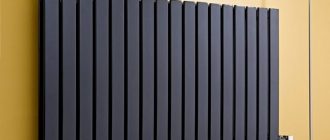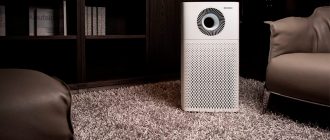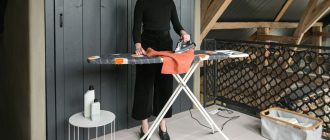In the absence of centralized heat supply for heating private houses, buildings, industrial premises, solid fuel heating boilers or their analogues are used. This article discusses the criteria for choosing boilers, their types and types, characteristics. Companies producing the best solid fuel boilers are listed. The rating of boilers is given depending on their power and design features.
| A place | Name | ||
How to choose a good solid fuel boiler
To choose a heating device, it is worth considering a number of the following characteristics.
Boiler power
Boiler power is one of the most important criteria for choosing heating equipment. The correct calculation of the power is a guarantee that the boiler will cope with the heating of the house and at the same time will work in the optimal economic mode.
Two main characteristics are used to calculate the power:
- room area;
- specific power per 10 sq.m. premises.
For a fully insulated house with a standard ceiling height of 10 sq. m. premises require 1.2 kW of power. Additionally, you need to add a power reserve to quickly warm up the house.
Number of contours
By the number of circuits, boilers can be of two types:
- single-circuit - perform only the heating function;
- double-circuit - used for heating and hot water supply.
When installing a single-circuit boiler, hot water supply can be provided by installing indirect heating boilers.
Principle of operation
According to the principle of operation, boilers are divided into the following types:
- Classic models. The easiest to operate and manufacture, and therefore the cheapest. By design, it is a direct descendant of a conventional furnace with a built-in heat exchanger circuit. They lack automation, boards and control units.
- Long burning boilers. The combustion of the material in them occurs from top to bottom, these models are arranged so that the fire burns in the upper part of the product. Thanks to the design, one tab of fuel is enough for a long time.
- Pellet. The fuel for such devices is sawdust pellets. They are loaded into the hopper and by the boiler automation they are fed into the combustion chamber. This design also allows the boiler to work for a long time after loading fuel.
- Pyrolysis. In this device, wood fuel, when burned, turns into combustible gas and charcoal. Both of these components are fed into the combustion chamber and, mixing with air, burn out practically without residue. This design can significantly improve efficiency.
Boiler efficiency
The efficiency is important to consider when choosing a boiler. It shows the effectiveness of a particular type of heating device. The efficiency directly depends on the type of unit:
- classic boilers - 80%;
- pallet and long-term combustion - 85%;
- pyrolysis - 90%.
Fuel type
Solid fuel boilers use different types of fuel, such as:
- coal;
- pellets;
- firewood;
- briquettes;
- coke;
- peat.
Heat exchanger material
The main materials for the manufacture of heat exchangers are cast iron and steel.
- Cast iron. The cast iron heat exchanger has a longer service life than steel, does not undergo perforating corrosion, has thermal inertness - it heats up for a long time, but cools down for a long time. The disadvantage is the likelihood of cracking of hot cast iron when cold water gets into it.
- Steel. Steel heat exchangers are not afraid of temperature fluctuations, but they are prone to perforating corrosion. Welding seams are also weak points.
Tips for choosing
- It is worth installing a boiler for which it is easier and cheaper to buy fuel. If coal or firewood is cheaper in the region of installation, you should give preference to equipment using such fuel. If at a certain time of the year one type of fuel is cheaper (for example, coal), and at other times another fuel is cheaper (for example, peat), then it is worth choosing a universal boiler that uses different types of fuel.
- If there is always a person in the house who can regularly put fuel into the boiler, then it is better to choose the classic version.
- For heating a large room, it is better to install a more advanced model - pyrolysis or long burning.
- For permanent use, a cast iron appliance is better suited; for use as an additional heater, it is worth installing a steel version.
- For heating and hot water supply, you should purchase a double-circuit version or a set of single-circuit and indirect heating boiler.
Manufacturer rating
The quality and performance of heating equipment is largely dependent on the brand. Serious companies value their reputation and produce excellent quality equipment. The most reliable boiler manufacturers are the following companies:
- Buderus Is a German manufacturer of heating equipment. Manufactures products of various types and capacities. The company was founded in 1731 and is still operating, which speaks of the quality of its products.
- Kentatsu Is a Japanese company with a half-century history. The largest manufacturer of climatic technology. A distinctive feature of boilers of this brand is reliability and durability.
- Lemax - a Russian manufacturer of heating equipment from Taganrog. Due to their high reliability and affordable prices, the company's products are in great demand.
- ZOTA Is a Russian brand. It produces a wide range of heating equipment of various capacities. Solid fuel units are made of steel. There are no cast iron models in the line.
- Teplodar - a well-established brand of Russian heating equipment. The range of manufactured equipment is not very wide, but the quality of products is not inferior to the best world companies.
Rating of the best solid fuel heating boilers in 2020
Classic solid fuel heating boilers are unpretentious in maintenance, do not depend on external power sources and are capable of reliably heating rooms. Perfectly suited for heating residential buildings, as well as for heating industrial premises, country houses for seasonal residence, summer cottages.
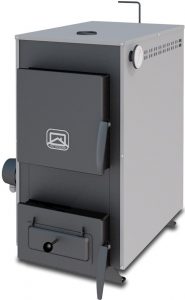
The best single-circuit solid fuel boiler of classic design, floor installation. Power 8 kW. Able to reliably heat rooms up to 80 sq. m. Completely non-volatile, does not require a power source. Works on such types of fuel as: firewood, coal, peat briquettes.It features a steel heat exchanger and an open combustion chamber. To maintain the coolant temperature at night and in emergency modes, it is additionally equipped with an electric heating element.
Advantages:
- fast heating of the coolant;
- small dimensions;
- loading firewood up to 40 cm long;
- full load is enough for 3 hours of burning.
Disadvantages:
- The efficiency is 80% overrated by the manufacturer;
- high exhaust gas temperature.
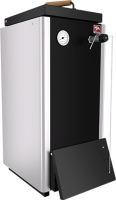
Floor standing good single-circuit solid fuel boiler of classic design. Power 17 kW for lignite and 16 kW for wood. Does not require a power source. It uses coal, wood, coke as fuel. The heat exchanger is shockproof, made of steel. Designed for heating residential and industrial premises up to 160 sq. m. For a power reserve, it should be used in rooms of no more than 140 square meters. m.
Advantages:
- convenient vertical loading chamber;
- grates are made of heat-resistant cast iron;
- anti-corrosion coating of the heat exchanger.
Disadvantages:
- lack of electric heating element.
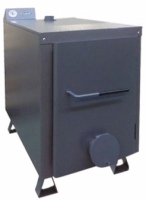
Floor standing single-circuit solid fuel boiler, classic layout. Non-volatile. Power 18 kW. Works on coal, wood, peat. Due to the low efficiency, about 65%, it heats rooms up to 120 sq. m. To maintain the coolant temperature, a heating element with a capacity of 2 kW is installed. A feature of this model is the presence of an automatic draft regulator, which allows working without outside interference for a long time. The body of the heating device does not heat up due to the water jacket and thermal insulation materials.
Advantages:
- combustion chamber of large size and volume;
- long operating time on one fuel load;
- operational safety;
- automatic power control.
Disadvantages:
- electric heating element of low power;
- low efficiency.
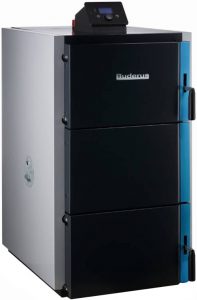
Power of the device is 50 kW, efficient heat supply of premises up to 450 sq.m. Duration of burning on one load up to 3 hours. The pyrolysis boiler is equipped with modern automation devices and ensures complete combustion of the fuel. It is possible to connect an indirect heating boiler.
Advantages:
- Efficiency-90%;
- the possibility of upgrading the control system;
- profitability.
Disadvantages:
- volatility;
- high price.
Combined boilers are more versatile heating devices. They can use both solid fuels and natural gas. The most well-proven models are as follows.
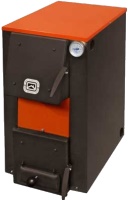
Good single-circuit floor-standing combination boiler. It uses wood, pellets, coal and gas as fuel. The power of this device is 9 kW. Heated area up to 90 sq. m. A distinctive feature of such a boiler is the presence of a flame arrester in the combustion chamber. Such a part increases the speed and efficiency of heat transfer.
Advantages:
- simple reliable design;
- the presence of electric heating elements;
- long burning system by sealing the furnace;
- wide options for upgrading.
Disadvantages:
- low efficiency;
- small combustion chamber;
- small loading port for solid fuel.
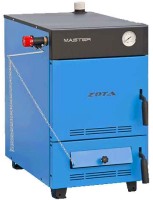
Single-circuit, floor-standing combination boiler. Power 20 kW. Able to reliably heat residential and industrial premises up to 150 sq. m.This device is versatile and can use wood, coal and anthracite as fuel. Additionally it can be equipped with a gas burner, electric heaters, and a pellet furnace. Instead of the standard mechanical power adjustment, it can be supplemented with an automatic boost system. A feature of this product is the heat exchanger. It consists of a large number of small-diameter tubes, which significantly improves heat transfer.
Advantages:
- large combustion chamber;
- long burning time;
- safety of use;
- great opportunities for modernization.
Disadvantages:
- poor equipment of the base model.
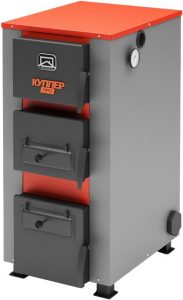
Nice single-circuit combi boiler, floor-standing. Power 22 kW. It is used for heating rooms up to 200 sq. m. Uses a wide range of fuels: gas, coal, pellets, firewood, briquettes. Gas and pellet burners must be purchased separately. Equipped with a flame arrester, multi-row heat exchanger and water jacket, which greatly improves the efficiency of the device.
Advantages:
- equipped with a heating element;
- ease of service;
- the possibility of modernization.
Disadvantages:
- inconvenience of loading fuel;
- short operating time on one load;
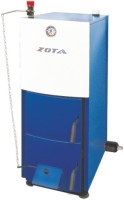
This device runs on wood, coal, anthracite. Also, optionally, burners can be installed for operation on pellets, natural and liquefied gas, diesel fuel. Heater power 31.5 kW. The ability to heat rooms up to 250 sq. m. Equipped with an X-shaped heat exchanger that increases the efficiency of the device.
Advantages:
- great opportunities for modernization;
- standard adjusting device.
Disadvantages:
- lack of heating element in the basic configuration.
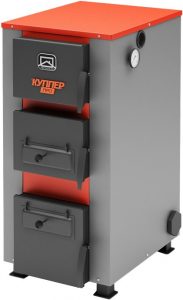
This heating device is considered a long burning boiler. One bookmark of firewood is enough for 8 hours of operation, in addition, the boiler operates on coal, peat briquettes. It can be completed with a gas and pellet burner, as well as a power regulator and remote control. The basic set includes a block of heating elements, with a three-phase connection. The power of the device itself is 36 kW. Effective heating area 300 sq. m.
Advantages:
- long burning time on one load;
- the possibility of modernization;
Disadvantages:
- narrow inlet for solid fuel.
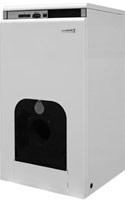
The fuel for this product is gas, fuel oil and diesel fuel. The heat exchanger is made of high quality cast iron. The device is equipped with electronic control and electric ignition. Power 30 kW. Designed for premises up to 250 sq. m. It can automatically maintain the temperature in the rooms by connecting heat sensors.
Advantages:
- profitability;
- autonomy;
- high efficiency.
Disadvantages:
- the need to purchase additional devices;
- a power source is required.
Buderus Logano G215
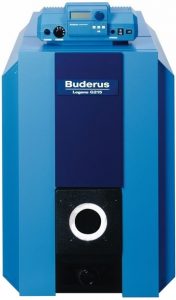
WS-52. Powered by gas and diesel. Power 52 kW, effective heating area 450 sq.m. The heat exchanger is made of cast iron. Equipped with electric ignition. Additionally, it can be equipped with an automatic temperature control unit in the building.
Advantages:
- powerful;
- economical;
- high efficiency;
Disadvantages:
- volatility;
- control unit and oil burner sold separately.

